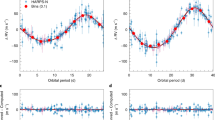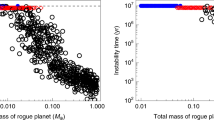Abstract
Multiple planet systems provide an ideal laboratory for probing exoplanet composition, formation history and potential habitability. For the TRAPPIST-1 planets, the planetary radii are well established from transits1,2, with reasonable mass estimates coming from transit timing variations2,3 and dynamical modelling4. The low bulk densities of the TRAPPIST-1 planets demand substantial volatile content. Here we show, using mass–radius–composition models, that TRAPPIST-1f and g probably contain substantial (≥50 wt%) water/ice, with TRAPPIST-1 b and c being significantly drier (≤15 wt%). We propose that this gradient of water mass fractions implies that planets f and g formed outside the primordial snow line whereas b and c formed within it. We find that, compared with planets in our Solar System that also formed within the snow line, TRAPPIST-1b and c contain hundreds more oceans of water. We demonstrate that the extent and timescale of migration in the TRAPPIST-1 system depends on how rapidly the planets formed and the relative location of the primordial snow line. This work provides a framework for understanding the differences between the protoplanetary disks of our Solar System versus M dwarfs. Our results provide key insights into the volatile budgets, timescales of planet formation and migration history of M dwarf systems, probably the most common type of planetary host in the Galaxy.
This is a preview of subscription content, access via your institution
Access options
Access Nature and 54 other Nature Portfolio journals
Get Nature+, our best-value online-access subscription
$29.99 / 30 days
cancel any time
Subscribe to this journal
Receive 12 digital issues and online access to articles
$119.00 per year
only $9.92 per issue
Buy this article
- Purchase on Springer Link
- Instant access to full article PDF
Prices may be subject to local taxes which are calculated during checkout



Similar content being viewed by others
References
Gillon, M. A. et al. Temperate Earth-sized planets transiting a nearby ultracool dwarf star. Nature 533, 221–224 (2016).
Gillon, M. et al. Seven temperate terrestrial planets around the nearby ultracool dwarf star TRAPPIST-1. Nature 542, 456–460 (2017).
Wang, S., Wu, D.-H., Barclay, T. & Laughlin, G. P. Updated masses for the TRAPPIST-1 planets. Preprint at https://arxiv.org/abs/1704.04290 (2017).
Quarles, B., Quintana, E., Lopez, E., Schlieder, J. & Barclay, T. Plausible compositions of the seven TRAPPIST-1 planets using long-term dynamical simulations. Astrophys. J. Lett. 842, L5–L11 (2017).
Dorn, C. et al. Can we constrain the interior structure of rocky exoplanets from mass and radius measurements? Astron. Astrophys 577, A83–A101 (2015).
Unterborn, C. T., Dismukes, E. E. & Panero, W. R. Scaling the Earth: a sensitivity analysis of terrestrial exoplanetary interior models. Astron. J. 819, 32–40 (2016).
Zeng, L., Sasselov, D. D. & Jacobsen, S. B. Mass–radius relation for rocky planets based on PREM. Astrophys. J. 819, 127–132 (2016).
Weiss, L. M. & Marcy, G. W. The mass–radius relation for 65 exoplanets smaller than 4 Earth radii. Astrophys. J. 783, L6–L13 (2014).
Rogers, L. A. Most 1A6 Earth-radius planets are not rocky. Astrophys. J. 801, 41–54 (2015).
Mottl, M., Glazer, B., Kaiser, R. & Meech, K. Water and astrobiology. Chem. Erde-Geochem. 67, 253–282 (2007).
Unterborn, C. T. & Panero, W. R. The effects of Mg/Si on the exoplanetary refractory oxygen budget. Astrophys. J. 845, 61–70 (2017).
Raymond, S. N., Quinn, T. & Lunine, J. I. Making other Earths: dynamical simulations of terrestrial planet formation and water delivery. Icarus 168, 1–17 (2004).
Lissauer, J. J. et al. Architecture and dynamics of Kepler's candidate multiple transiting planet systems. Astrophys. J. Suppl. Ser. 197, 8–34 (2011).
Fabrycky, D. C. Architecture of Kepleras multi-transiting systems. II. New investigations with twice as many candidates. Astrophys. J 790, 146–158 (2014).
Steffen, J. H. & Hwang, J. A. The period ratio distribution of Kepler’s candidate multiplanet systems. Mon. Not. R. Astron. Soc. 448, 1956–1972 (2015).
Chiang, E. & Goldreich, P. Spectral energy distributions of T Tauri stars with passive circumstellar disks. Astrophys. J. 490, 368–376 (1997).
Baraffe, I., Chabrier, G., Allard, F. & Hauschildt, P. H. Evolutionary models for low-mass stars and brown dwarfs: uncertainties and limits at very young ages. Astron. Astrophys. 382, 563–572 (2002).
Lee, E. J. & Chiang, E. Breeding super-earths and birthing super-puffs in transitional disks. Astrophys. J. 817, 90–101 (2016).
Gaidos, E. A minimum mass nebula for M dwarfs. Mon. Not. R. Astron. Soc. 470, L1–L5 (2017).
Noack, L. et al. Water-rich planets: how habitable is a water layer deeper than on Earth? Icarus 277, 215–236 (2016).
Barr, A. C., Dobos, V. & Kiss, L. L. Interior structures and tidal heating in the TRAPPIST-1 planets. Preprint at https://arxiv.org/abs/1712.05641 (2017).
Kite, E. S., Manga, M. & Gaidos, E. Geodynamics and rate of volcanism on massive Earth-like planets. Astrophys. J. 700, 1732–1749 (2009).
Lopez, E. D., Fortney, J. J. & Mille, N. How thermal evolution and mass-loss sculpt populations of super-Earths and sub-Neptunes: application to the Kepler-11 system and beyond. Astrophys. J. 761, 59–72 (2012).
Bedell, M. et al. Kepler-11 is a solar twin: revising the masses and radii of benchmark planets via precise stellar characterization. Astrophys. J 839, 94–106 (2017).
Stökl, A., Dorfi, E. & Lammer, H. Hydrodynamic simulations of captured protoatmospheres around Earth-like planets. Astron. Astrophys. 576, A87–A98 (2015).
Watson, A. J., Donahue, T. M. & Walker, J. C. G. The dynamics of a rapidly escaping atmosphere: applications to the evolution of Earth and Venus. Icarus 48, 150–166 (1981).
Erkaev, N. V. et al. Roche lobe effects on the atmospheric loss from ‘hot Jupiters'. Astron. Astrophys 472, 329–334 (2007).
Wheatley, P. J., Louden, T., Bourrier, V., Ehrenreich, D. & Gillon, M. Strong XUV irradiation of the Earth-sized exoplanets orbiting the ultracool dwarf TRAPPIST-1. Mon. Not. R. Astron. Soc. 465, L74–L78 (2017).
Burgasser, A. J. & Mamajek, E. E. On the age of the TRAPPIST-1 system. Astrophys. J. 845, 110–120 (2017).
Connolly, J. A. D. The geodynamic equation of state: what and how. Geochem. Geophys. Geosyst. 10, https://doi.org/10.1029/2009GC002540 (2009).
Stixrude, L. & Bukowinski, M. S. T. Fundamental thermodynamic relations and silicate melting with implications for the constitution of D″. J. Geophys. Res. Solid Earth 95, 19311–19325 (1990).
Bond, J. C., O’Brien, D. P. & Lauretta, D. S. The compositional diversity of extrasolar terrestrial planets. I. In situ simulations. Astrophys. J. 715, 1050–1070 (2010).
Thiabaud, A., Marboeuf, U., Alibert, Y., Leya, I. & Mezger, K. Elemental ratios in stars vs planets. Astron. Astrophys. 580, A30–A37 (2015).
McDonough, W. F. in Treatise on Geochemistry, Vol. 2 (ed. Carlson, R. W.) 547–568 (Elsevier, Amsterdam, 2003).
Hinkel, N. R., Timmes, F. X., Young, P. A., Pagano, M. D. & Turnbull, M. C. Stellar abundances in the solar neighborhood: the Hypatia Catalog. Astron. J. 148, 54–87 (2014).
Zapolsky, H. S. & Salpeter, E. E. The mass–radius relation for cold spheres of low mass. Astrophys. J. 158, 809–813 (1969).
Seager, S., Kuchner, M., Hier-Majumder, C. A. & Militzer, B. Mass–radius relationships for solid exoplanets. Astrophys. J. 669, 1279–1297 (2007).
Zeng, L. & Sasselov, D. A detailed model grid for solid planets from 0.1 through 100 Earth masses. Publ. Astron. Soc. Pac. 125, 227–239 (2013).
Stixrude, L. & Lithgow-Bertelloni, C. Thermodynamics of mantle minerals—I. Physical properties. Geophys. J. Int. 162, 610–632 (2005).
Anderson, W. W. & Ahrens, T. J. An equation of state for liquid iron and implications for the Earth’s core. J. Geophys. Res. 99, 4273–4284 (1994).
Hinkel, N. R. et al. A comparison of stellar elemental abundance techniques and measurements. Astrophys. J. Suppl. Ser. 226, 4–70 (2016).
Hinkel, N. R.. et al. A Catalog of Stellar Unified Properties (CATSUP) for 951 FGK-Stars within 30 pc. Astrophys. J. 848, 34–53 (2017).
Anders, E. & Grevesse, N. Abundances of the elements: meteoritic and solar. Geochim. Cosmochim. Ac. 53, 197–214 (1989).
Mauersberger, K. & Krankowsky, D. Vapor pressure above ice at temperatures below 170 K. Geophys. Res. Lett. 30, 1121–1131 (2003).
Kennedy, G. M. & Kenyon, S. J. Planet formation around stars of various masses: the snow line and the frequency of giant planets. Astrophys. J. 673, 502–512 (2008).
Swift, J. J. et al. Characterizing the cool KOIs. IV. Kepler-32 as a prototype for the formation of compact planetary systems throughout the Galaxy. Astrophys. J 764, 105–119 (2013).
Lodders, K. Solar System abundances and condensation temperatures of the elements. Astrophys. J. 591, 1220–1247 (2003).
Backus, I. & Quinn, T. Fragmentation of protoplanetary discs around M-dwarfs. Mon. Not. R. Astron. Soc. 463, 2480–2493 (2016).
Kuchner, M. J. A minimum-mass extrasolar nebula. Astrophys. J. 612, 1147–1151 (2004).
Desch, S. J. Mass distribution and planet formation in the solar nebula. Astrophys. J. 671, 878–893 (2007).
Chiang, E. & Laughlin, G. The minimum-mass extrasolar nebula: in situ formation of close-in super-earths. Mon. Not. R. Astron. Soc. 431, 3444–3455 (2013).
Tanaka, H., Takeuchi, T. & Ward, W. R. Three-dimensional interaction between a planet and an isothermal gaseous disk. I. Corotation and Lindblad torques and planet migration. Astrophys. J. 565, 1257–1274 (2002).
Walsh, K. J., Morbidelli, A., Raymond, S. N., O’Brien, D. P. & Mandell, A. M. A low mass for Mars from Jupiter’s early gas-driven migration. Nature 475, 206–209 (2011).
Acknowledgements
C.T.U. acknowledges the support of Arizona State University through the SESE Exploration fellowship. The results reported herein benefited from collaborations and/or information exchange within NASA’s Nexus for Exoplanet System Science (NExSS) research coordination network sponsored by NASA’s Science Mission Directorate. N.R.H. would like to thank CHW3 and acknowledges the support of the Vanderbilt Office of the Provost through the Vanderbilt Initiative in Data-intensive Astrophysics (VIDA) fellowship.
Author information
Authors and Affiliations
Contributions
C.T.U. and S.J.D. conceived the project and wrote the manuscript. C.T.U. performed the mass–radius–composition calculations. S.J.D. constructed the snow line model and performed the atmospheric retention calculations. N.R.H. supplied the input stellar data and helped to prepare the manuscript. C.T.U. and A.L. wrote the ExoPlex mass–radius–composition calculator.
Corresponding author
Ethics declarations
Competing interests
The authors declare no competing interests.
Additional information
Publisher’s note: Springer Nature remains neutral with regard to jurisdictional claims in published maps and institutional affiliations.
Supplementary information
Supplementary Information
Supplementary Figures 1–3
Rights and permissions
About this article
Cite this article
Unterborn, C.T., Desch, S.J., Hinkel, N.R. et al. Inward migration of the TRAPPIST-1 planets as inferred from their water-rich compositions. Nat Astron 2, 297–302 (2018). https://doi.org/10.1038/s41550-018-0411-6
Received:
Accepted:
Published:
Issue Date:
DOI: https://doi.org/10.1038/s41550-018-0411-6
This article is cited by
-
No thick carbon dioxide atmosphere on the rocky exoplanet TRAPPIST-1 c
Nature (2023)
-
Atomic-scale mixing between MgO and H2O in the deep interiors of water-rich planets
Nature Astronomy (2021)
-
An upper limit on late accretion and water delivery in the TRAPPIST-1 exoplanet system
Nature Astronomy (2021)
-
A Review of Possible Planetary Atmospheres in the TRAPPIST-1 System
Space Science Reviews (2020)
-
A water budget dichotomy of rocky protoplanets from 26Al-heating
Nature Astronomy (2019)



